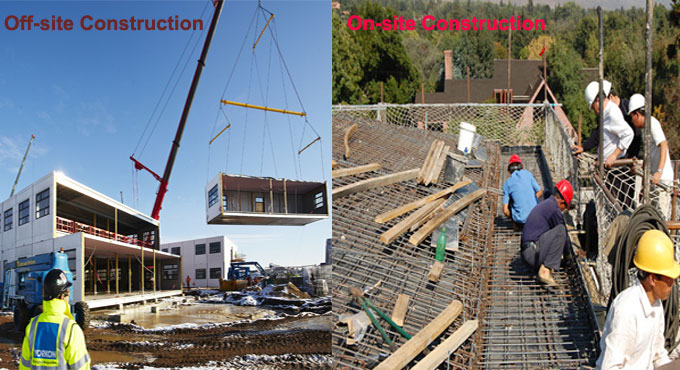
Advantages and Disadvantages of On-site and Off-site Construction
The needs and restrictions at your construction project may make you choose between one of the two main methods of construction: on-site and off-site. Both are widely used in today?s construction industry, depending upon the requirements at the site and according to design.
What is On-Site Construction?
On-site construction is the more traditional method. Here, structures are assembled from raw materials at the site itself, hence the name. The method has to be carried out sequentially and materials needs to be stored and used at the site.
What is Off-Site Construction?
With modern technologies, off-site method of construction has become possible. In this, parts or blocks of the structure are constructed in a designated factory or yard in standardized process. Then, these pre-built blocks are carried to the project site where they are assembled together to form the structure.
Both of the above methods have their own advantages and disadvantages, which make them suitable to different scenarios. Let?s discuss them below.
On-Site Construction
Advantages:
1. Customized Design: Since there is no restriction on what shape of objects are available of construction, there are limitless customization options in this manner. In fact most non-standard designs have to rely upon the on-site method just for this.
2. Alteration: After the construction you can easily modify the structure with this method. It doesn?t require you to depend upon third-party construction factories to add or change a room in your house that has been constructed in the traditional method.
3. Space-friendly: Transporting precast blocks in tight urban areas can get simply impossible. More often, it?s prohibitively expensive. In these scenarios you have no choice but to construct everything on-site.
Disadvantages:
1. Dependant upon weather: Since everything is getting mixed and built on the site, a bit of rain or snow can ruin a lot.
2. Unsafe: Due to storing everything on-site and casting them right there, the dangers of mischief and accidents have an increased probability here.
3. Inflexible: Once it?s done, it?s done. After construction, for any kind of moderation you have to break down stuff or build the difference from scratch.
Off-Site Construction
Advantages:
1. Independent of weather: Since the blocks are constructed in a covered yard or factory, weather cannot affect the process. Also, the assembly process isn?t affected by weather either.
2. Speedier process: Since the construction of blocks and assembling of another part of construction can go simultaneously on and off site, the whole process takes about half the time than that of the traditional methods. Also, manufacturing standardization means faster construction of blocks.
3. Better quality: Standardized manufacturing process and the regular quality checks before delivery ensures that you?re almost assuredly getting much better stuff.
4. Much safer: Less chance of material getting stolen or accidents. Also, generally the prefabricated blocks are lighter to work with, meaning less injuries.
5. Less energy and waste: Since the whole process is streamlined and less customized, it requires less energy in terms of fuel or power. Also, since almost no raw material is being used on-site, very little waste and pollution is generated.
6. Flexible: Buildings with prefabricated blocks can be disassembled and reassembled in another design or even in another place.
7. Sustainable: Most prefabricated building blocks are made from environment-friendly sustainable material.
Disadvantages:
1. Not customizable: since the construction is being done with prefabricated building blocks, you don?t have many choices. Also, once construction starts, you have little leeway to change anything.
2. Accessible location required: transporting the blocks requires a well-accessible site. At sites with restricted or cramped access, you have no choice but to revert to on-site method.
3. Complicated: the off-site method requires shrewd, highly detailed planning and design, since you can?t just ?wing it? during construction.
4. Dependent upon third-party: the constructor on-site must be in exceptionally clear contact with the blocks supplier, so that nothing unintended or undesired comes.


